Dakota Crescent
Dakota Crescent (Chinese: 达哥打弯) is one of Singapore’s oldest housing estates built by Singapore Improvement Trust (SIT), the housing authority before the Housing and Development Board (HDB), in 1958.[1] Today, there are only 15 remaining blocks. These low-rise flats are located at Old Airport Road, right next to Mountbatten Mass Rapid Transit (MRT) station. Many of the residents residing in Dakota Crescent were once victims of kampong fires; mainly from the "Friday the 13th fire" at Kampong Tiong Bahru on 13 February 1959 and the fire at Kampong Koo Chye on 5 April 1958 (now Lorong 3 Geylang).[2][3][4]
In order to build Dakota Residences and Waterbank at Dakota, a total of 15 blocks, namely blocks 34 to 56, 68, 70 and 72, were demolished. In particular, blocks 68, 70 and 72 were listed for Selective En-bloc Redevelopment Scheme (SERS) in 1999. Residents of these blocks moved to the replacement flats, which were located at Pine Green (blocks 39, 43, 45, 47 and 49 Jalan Tiga), in 2004. In 2014, Dakota Crescent is being earmarked for redevelopments under Mountbatten’s estate renewal plan and residents are expected to relocate by the end of 2016.[5]
History of Dakota Crescent
In the 1950s, the housing in Singapore was insufficient for its growing population and an increasing number of people were living in places with slum-like conditions and poor sanitation. As the central area of Singapore became congested, the colonial government decided to come up with new public housing estates to tackle the problem. One of the plans was to develop the Kallang Area into Singapore’s equivalent of London’s Hyde Park. This master plan was reported in The Straits Times, dated 11 March 1955.[6]
The low-rise brick-clad flats were built by SIT in the British colonial days 1958. Completed in 1958, it was later handed over to HDB in 1960.[7] When Kallang Airport was closed in 1955, the old runway which ran parallel to Mountbatten Road became Old Airport Road, while the surrounding public flats became known as Old Airport Estate or Kallang Airport Estate.[8] The Old Kallang Estate had a total of 2,936 housing units equipped with modern amenities such as piped water, flush toilets and electricity. Dakota Crescent was one part of the Old Kallang Estate and was also the first estate to feature one-room flats.[9]
Dakota Crescent was named after an American aircraft called Douglas DC-3 Dakota, which commonly landed at Kallang Airport before it was closed. It also commemorates an aviation disaster which happened on 29 June 1946, which killed all the passengers on board, when one of the Royal Air Force's Dakota aircraft crashed at Kallang Airport in a thunderstorm.[5]
Architecture of Dakota Crescent
Open Spaces and Red-Bricked Flats
The design of SIT flats was modelled after British towns and done by architects who worked for the colonial government. The early housing estates in Singapore adapted various architectural elements of the British architectural styles in order to suit the tropical climate.[1] This can be seen from the existence of many open spaces, like that of London’s Hyde Park as discussed previously, and the red-bricked flats at Dakota Crescent in the past.
The open spaces, which still exist today, are pedestrian-friendly and have many uses, one of which is for children to play at ease. Spaces like these are no longer commonly found in housing estates of Singapore now, since flats are built in a more compact way to save land space. On the other hand, red bricks are very suitable building blocks for housing in Singapore as it is a material that has the following three properties – fire protection, high wind protection and superior moisture control.[10] Furthermore, these red-bricked flats served as an icon of Dakota Crescent. People are instantly reminded of the Old Kallang Estate or Dakota Crescent upon hearing phrases such as “red-bricked houses”.[11] Unfortunately, the flats at Dakota Crescent were eventually painted in order to prevent erosion from the rain, termite infestation, etc. The flats were painted at least twice, after 2002. Some of the paint on these flats are already seen peeling, revealing the original red bricks.
Building Typologies
Dakota Crescent now consists of 15 blocks of low-rise flats, with the highest blocks being 7 storey high. There are 4 types of building typologies,[5] which are as follows:
1. 7-storey butterfly-shaped (pi-shaped) blocks (Blocks 2, 4, 6, 14, 18, 22, 28 and 30)
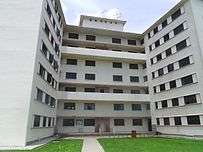
These flats are shaped in this way, instead of the usual long blocks, so as to easily fit as many blocks as possible in Dakota Crescent. In order to keep the number of units are the same even when making the blocks compact, the center is being pushed out to create the wings. The curvature of the road might also be the reason to why these blocks are curved.
2. 3-storey walk-up apartments (Blocks 16, 24, 26 and 32)
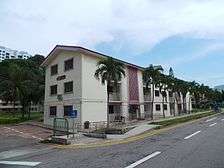
3. 2-storey commercial blocks/shop house (Block 12)
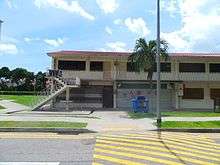
The first storey was commercialized and used as shop houses e.g. Tian Kee & Co. Provision Shop, while the second storey was residential.
4. 7-storey slab (straight) blocks (Blocks 10 and 20)
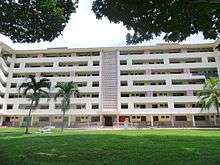
The butterfly-shaped blocks, walk-up apartments and commercial shop houses are unique to Dakota Crescent and cannot be found elsewhere, unlike the straight blocks which are replicated and can be found in other SIT estates. However, the estates which had the straight blocks were demolished and the two blocks in Dakota are the last surviving ones.
Neon Light Advertisement
In the 1960s, the use of neon lights for advertisement billboards was first introduced in Singapore.[12] Even though this form of advertising only takes up less than a percent of the total advertising expenditure in Singapore, there were still a number of public supporters and companies which wanted to use neon advertisements. These advertisements are placed on the walls of prominent buildings, with those along the roads being easier to spot and hence more attractive. Places such as South Bridge Road and Guillemard Circus had these neon advertisements.[13] Similarly, Block 6 of Dakota Crescent used to have one of these neon light advertisements as well (Figures 28 and 29). Unfortunately, neon advertisement business later died down in Singapore and hence we do not see the signboard on Block 6 today.
Balconies
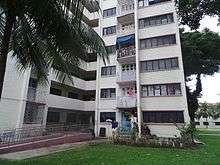
The balconies at Dakota Crescent are very unusual and different from the modern HDB flats’ balconies – one can easily see many of the balconies at Dakota Crescent having metal grills and brightly painted louvered doors, which are breathable. It is said that the balconies were painted visually different by the residents themselves, who were afraid of getting lost, so that they can recognize their houses at a glance.
Vintage Schindler Traction Elevator[14]

The lifts at Dakota Crescent, installed by Schindler in 1958 , are still in working condition despite being very old and different from the ones used in modern HDB flats. They stop only on certain floors instead of every floor and hence can be quite inconvenient for residents, especially the elderly or handicapped. Furthermore, there are only two people left in Singapore who can give maintenance or repair these lifts if they break down. The lifts are also placed on slightly higher grounds (Figure 34) and this elevation serves as flood mitigation for the estate, which used to be prone to floods whenever it rained.
Rubbish Chutes

Each block in Dakota Crescent has a common rubbish chute for hygiene purposes.
Lost Connections
Dove Playground
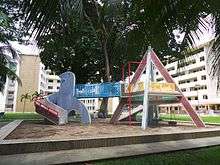
The Dove Playground, another significant icon of Dakota Crescent, was designed by Mr Khor Ean Ghee in 1979. Mr Khor had been asked by HDB to come up with play spaces for a new generation of public housing that would “go beyond providing just a roof over Singaporeans’ heads”. Even though he had no experience in designing playgrounds, Mr Khor began creating playgrounds based on animals and local icons like rickshaws. The dove playground was one of his designs for the series of animal-inspired adventure playgrounds.[15] As of today, it is still situated at Dakota Crescent, with a metal bridge linking the concrete dove to the pyramidal structure which has rubber tyres swings under it.
This playground definitely contains many childhood memories of the residents, since back in the 1950s, children do not have technological devices and they would play in the vast open spaces, in muddy waters and also at this playground. One of the residents, Xue Ling, mentioned that the playground often gets flooded when it rains, and that she would put on her swimsuit to swim in the muddy water with her sister.
Besides children, adults also gather around here for conversations and social bonding. Madam Yee, a resident of more than 35 years, said, “What I like most about this place is the friendship that I’ve forged throughout the years. I live alone and it’s good that my neighbours check up on me when they have the time. Sometimes if I get bored, I go down to the playground and chitchat with them. When all of us have to shift out in 2016, hopefully, the bond between our neighbours will remain intact.”[16]
Tian Kee & Co. Dakota Crescent
At the corner of Block 12, there used to an old provision shop opened by an elderly couple for over 50 years, before it was sold in late 2013. The shop was easily recognizable by its old signboard, which the uncle revealed that it was made by themselves. There was also the smell of butter and dried goods coming from the provision shop, with tins of biscuits lining the walls. Chanel Hu recalled, “I remember dropping the shop when I was younger. Mr Lim was always kind, courteous and giving, offering me a handful of local biscuits every time I visited. At times we spoke, he would tell me about how Singapore used to be – the sense of community, old friends and older customers.”[16]
After being sold in 2013, the old provision shop became a popular café, which is filled with old-school and nostalgic vibes.
Now, the café had ceased operations since 30 December 2016 due to Dakota Crescent being listed as one of the estates under the SERS. All the other shop houses at Block 12 have been closed down too.
Geylang River
Before Geylang River was canalized, Dakota Crescent was prone to floods. Billy, who lived here for more than 50 years, talked about his experience with the floods: “One early morning, I went out to the market for breakfast, and when I returned home, it was like an island since it was a standalone flat.”
Now, Dakota Crescent is no longer as vulnerable to floods as it was, as Geylang River is canalized. The drainage system reduces flood damage by carrying water away from the estate when it rains.
Tung Ling Community Services
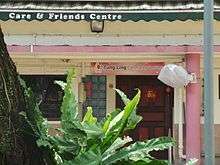
The centre is a place for elderly to participate in various activities like playing bingo, playing mahjong and singing. It is located in the neighbourhood of Dakota Crescent and sounds of cheering can often be heard from the centre.[16] However, now that most residents have shifted to Cassia Estate, the centre is not as lively as it used to be.
Cassia Estate
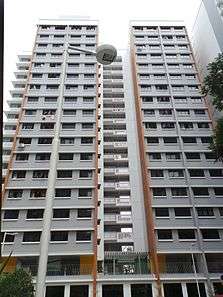
Dakota Crescent has over 600 one or two-room units, but only 60 percent of them are occupied, majority on a rental basis.[17] More than 300 of these residents have moved out, either to Cassia Estate Block 52, which is a few streets away, or to other housing estates in Singapore. Even though most of the residents moved to Cassia Estate Block 52, a lot of them faced a change in neighbours since they did not choose flats of the same floor. Despite having a common space on the second level, the seats are in groups of four and hence not utilized by the residents who usually have activities in bigger groups. Residents gather at the ground floor instead, but the open spaces are very limited. All these reasons contributes to the possibility of lost connections between the residents.
Conservation Efforts and Public Awareness
Dakota Crescent is a place with a substantial history and has many valuable architectural styles which cannot be found in the modern public housing estates anymore. The stories of the residents who have lived there for decades make Dakota Crescent even more interesting and special. Many people who have the same thoughts came together and tried very hard to conserve this place. Conservation efforts include a ‘Save Dakota’ Facebook page, ‘Dakota Adventures’ which consists of a group of people giving Dakota Crescent tours to raise more awareness of this issue. Other than an increasing number of people contributing to the conservation efforts, the increase in public awareness can also be seen from the fact that many production teams chose Dakota Crescent as the site of their film locations, for instance, the movie ‘3688’ (2015) by director Royston Tan.[18] Even though Dakota Crescent has been set for redevelopment, there are no explicit plans of what to do with the estate yet. It seems that Dakota Crescent, at least some of the blocks, will be conserved after all.[19]
References
- 1 2 Who, V. (Ed.). (2016). Architecture and the architect: Image-making in Singapore. United Kingdom: Oro Editions.
- ↑ http://www.straitstimes.com/singapore/housing/2016-expiry-date-for-dakota-crescent-flats
- ↑ 1,000 Kallang flats are set aside (1959, February 17). The Straits Times. Retrieved from http://eresources.nlb.gov.sg/newspapers/Digitised/Article/straitstimes19590217-1.2.39
- ↑ Flats for fire victims (1958, May 27). The Straits Times. Retrieved from http://eresources.nlb.gov.sg/newspapers/Digitised/Page/straitstimes19580527-1.1.2
- 1 2 3 https://lostnfiledsg.wordpress.com/2014/09/13/dakota-crescent-neighbourhood/
- ↑ A “HYDE PARK” for S’PORE, Kallang to be made a community centre (1955, March 11). The Straits Times. Retrieved from http://eresources.nlb.gov.sg/newspapers/Digitised/Page/straitstimes19550311-1.1.5
- ↑ http://www.straitstimes.com/singapore/5-things-to-remember-about-dakota-crescent
- ↑ Yeoh, P. B., & Wong, T. (2016). Over Singapore 50 years ago: An aerial view in the 1950s. Singapore, Singapore: Editions Didier Millet.
- ↑ http://broadricksec.moe.edu.sg/school/our-heritage
- ↑ http://www.gobrick.com/resources/why-choose-brick
- ↑ https://www.youtube.com/watch?v=Ki6GiKPHaKQ
- ↑ Clear device makes advertisements bright and colourful (1960, July 19). The Singapore Free Press. Retrieved from http://eresources.nlb.gov.sg/newspapers/Digitised/Article/freepress19600719-1.2.97
- ↑ Brightening up Singapore (1988, December 15). New Paper. Retrieved from http://eresources.nlb.gov.sg/newspapers/Digitised/Article/newpaper19881215-1.2.7.1
- ↑ http://oursingaporememories.blogspot.sg/2015/01/dakota-crescent-colonial-public-housing.html
- ↑ https://www.sg/en/SG50/Pulse/Space%20For%20A%20Nation%20to%20Play.aspx
- 1 2 3 Tan, A. (Ed.). (2015). Urban Sketchers Singapore Volume 2. Singapore: Tia Boon Sim.
- ↑ https://www.99.co/blog/singapore/lights-out-dakota-crescent/
- ↑ http://www.straitstimes.com/lifestyle/entertainment/singapore-film-makers-take-st-to-key-filming-locales-for-their-movies
- ↑ http://mothership.sg/2017/01/3-reasons-why-we-can-be-optimistic-about-dakota-crescents-conservation/